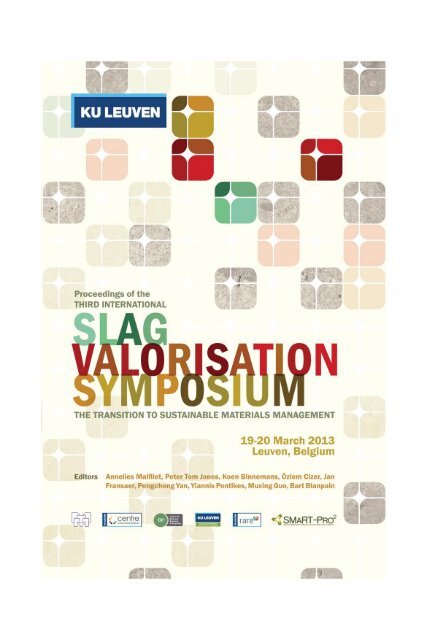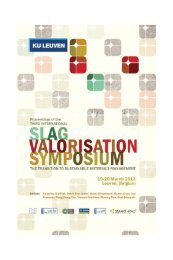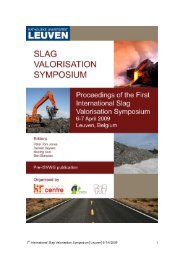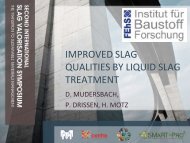Paper - Third International Slag Valorisation Symposium
Paper - Third International Slag Valorisation Symposium
Paper - Third International Slag Valorisation Symposium
Create successful ePaper yourself
Turn your PDF publications into a flip-book with our unique Google optimized e-Paper software.
PH DEPENDENT LEACHING BEHAVIOUR OF Zn, Cd, Pb<br />
AND As FROM SLAGS: KINETICS AND MINERALOGICAL<br />
CONTROL<br />
Valérie CAPPUYNS 1,2 , Vajiheh ALIAN 1 , Elvira VASSILIEVA 1 , Rudy<br />
SWENNEN 1<br />
1 Department of Earth and Environmental Sciences, KU Leuven, 3001 Leuven, Belgium<br />
2 Faculty of Management and Economics, HUBrussel, 1000 Brussels, Belgium<br />
valerie.cappuyns@hubrussel.be, rudy.swennen@ees.kuleuven.be<br />
Abstract<br />
From the Middle Ages until the beginning of the 20th century, extensive Pb-Zn mining<br />
and smelting was carried out in East-Belgium. By lack of waste treatment techniques and<br />
sustainable management practices, metal-bearing slags and unprocessed waste were<br />
dumped in huge tailings, which still represent an important source of contamination. A<br />
chemical and mineralogical characterisation of different types of waste material<br />
originating from the former Pb-Zn mining industry was performed in order to gain a<br />
better understanding of the slag properties, with special attention to heavy metal release<br />
under varying pH conditions, and to bring this in relation to different management<br />
scenarios.<br />
Introduction<br />
In the mining industry, 3 principal processes can be distinguished, namely mining,<br />
mineral processing and mineralogical extraction 1 . Depending on the origin of the<br />
minerals and the processing conditions of the minerals, the waste materials of these<br />
processes show different properties. Additionally, mining waste generally contains<br />
hazardous substances such as heavy metals, radioactive elements, cyanides, etc. which<br />
can potentially be released under changing environmental conditions, such as changes in<br />
pH, (especially when the waste produces acid mine drainage), redox conditions (for<br />
example, when (periodical) inundation of the mine waste is possible) or microbial<br />
activity. From the Middle Ages until the beginning of the 20th century, extensive Pb-Zn<br />
mining and smelting was carried out in East-Belgium. Due to the lack of better waste<br />
treatment techniques and of sustainable management practices, metal-bearing slags and<br />
unprocessed waste were dumped. Metallurgical processing of these Pb-Zn minerals<br />
occurred at several locations, mainly in the northern part of Belgium, also generating<br />
important quantities of waste. A chemical and mineralogical characterisation of different<br />
types of waste materials related to the former Pb-Zn mining industry was performed in<br />
order to gain a better understanding of their properties, with special attention to heavy<br />
3 rd <strong>International</strong> <strong>Slag</strong> <strong>Valorisation</strong> <strong>Symposium</strong> | Leuven | 19-20/03/2013 299
metal release under varying pH conditions, and to bring this in relation to different<br />
management scenarios.<br />
Methodology<br />
In La Calamine, Plombieres and Angleur (East-Belgium), samples consisting of<br />
respectively dredged mine tailing pond sediments, mineral processing waste and waste<br />
from the metallurgical process of Zn-production were collected after a preliminary<br />
screening and analysis of vertical profiles. In Overpelt (North-Belgium), two waste<br />
samples were obtained from a plant for Zn powder manufacturing by air atomisation<br />
("blown zinc") for primary batteries. Total metal concentrations, pH, cation exchange<br />
capacity (CEC) and grain size distribution were determined for all the samples and a<br />
mineralogical (petrography, XRD, SEM-EDX) investigation was carried out. pHstat leaching<br />
tests and geochemical modelling of the pH-dependent leaching behaviour were<br />
performed 2 .<br />
Results and discussion<br />
Mineralogical and physico-chemical characterisation<br />
The waste materials from the four locations were mainly contaminated with Zn, Pb, Cd,<br />
Cu and/or As (Table 1). pH was neutral to slightly alkaline for the samples from La<br />
Calamine (CA) and Angleur (AN), whereas pH was slightly acidic in the samples from<br />
Plombiéres (PB) and Overpelt (OV).<br />
Table 1: Total element concentrations, pH and CEC (ND: not determined)<br />
Sample Zn Cd Pb Cu As Ca Al Fe S pH CEC<br />
mg kg<br />
%<br />
-<br />
mg kg<br />
1<br />
%<br />
-<br />
mg kg<br />
1<br />
-<br />
cmol kg<br />
1<br />
% % %<br />
-1<br />
g kg -<br />
1<br />
AN 3.09 124 1.95 1704 1928 2.22 2.45 9.48 ND 8.0 ND<br />
CA1 10.81 297 2.06 60 1491 4.72 3.08 11.77 12.70 6.5 ND<br />
CA2 6.77 4196 0.03 29 28 5.57 2.79 2.81 2.57 7.5 ND<br />
PB1 1.16 63 0.52 1023 474 1.9 6.21 5.87 0.22 5.3 1.33<br />
PB2 2.79 68 0.61 6642 545 1.34 2.75 7.87 0.35 5.7 1.83<br />
OV1 3.56 48 1.92 5383 3391 1.52 2.20 19.19 2.96 5.9 19.96<br />
OV2 0.47 5 0.24 604 141 1.66 7.92 9.09 0.38 5.8 3.35<br />
The main minerals in the La Calamine samples were sfalerite, smithsonite, anglesite,<br />
cerrusite, galena, pyrite and marcasite in sample CA1 and secondary minerals such as<br />
smithsonite, siderite and gypsum in sample CA2. In the slag sample from Angleur, XRD<br />
analysis revealed the presence of troilite, arsenopyrite, willemite, and magnesioferrite.<br />
SEM-EDX investigation also indicated the occurrence of amorphous silicate phases (glass<br />
300 3 rd <strong>International</strong> <strong>Slag</strong> <strong>Valorisation</strong> <strong>Symposium</strong> | Leuven | 19-20/03/2013
Figure 1: pH-dependent leaching behaviour of Pb, Cd and As in sample CA1 (a) and AN<br />
(b). Total Pb-, Cd- and As-concentrations and pH are indicated below the graphs<br />
phases). The slag from Overpelt, sample OV1 is mainly composed of opaque phases (> 80<br />
wt%) and minor amounts of quartz, hematite, goethite, and probably also melilite.<br />
Sample OV2 mainly contains Fe-oxides and quartz, fluorite, albite and melilite. The slags<br />
from Plombières are composed of iron oxides and quartz, feldspar, fluorite and mullite.<br />
Combining leaching test results with mineralogical analysis and<br />
thermodynamical modelling<br />
For the La Calamine samples, a pH-increase significantly decreases the leachability of Zn,<br />
Cd and Pb, whereas the solubility of As is not affected and remains very low (Figure 1a).<br />
The results from the pHstat leaching tests, combined with solid-phase characterisation<br />
(XRD, SEM-EDX) and thermodynamical modelling (MINTEQA2) confirmed that the<br />
solubility of Zn, Pb and Cd is mainly controlled by Pb-Zn minerals (e.g. smithsonite). The<br />
slag sample from Angleur contains arsenopyrite, a mineral that normally decomposes in<br />
oxidising conditions. However, during pHstat leaching under oxidising conditions almost<br />
no As was released in the pH range 2–8 (Figure 1a). This can be attributed to the<br />
occurrence of this mineral as minute phases occluded in glass phases, protecting the<br />
mineral from acid dissolution (Figure 1b). In the samples from Overpelt and Plombières,<br />
the release of Zn, Pb and Cd was not controlled by Pb-Zn minerals, but by the reactivity<br />
of glass phases and Fe-(hydr) oxides in which these heavy metals are occluded.<br />
Kinetics of element release during pHstat leaching<br />
Even when similar amounts of heavy metals are released at the end of a pHstat leaching<br />
test, the kinetics of heavy metal release can greatly differ, which also provides<br />
information on their reactivity in the mining waste samples. For example, in the Angleur<br />
sample (AN), the release of Pb was constant with time (related to the slow dissolution of<br />
glass phases), whereas in other samples (CA2 and PB2) the release of Pb was initially<br />
fast, followed by a decrease in release rate (Figure 2).<br />
3 rd <strong>International</strong> <strong>Slag</strong> <strong>Valorisation</strong> <strong>Symposium</strong> | Leuven | 19-20/03/2013 301
Conclusion<br />
Figure 2: Release of Pb (% of total content) during pHstat leaching at pH4<br />
A high variability in physico-chemical and mineralogical properties of mining waste<br />
exists, even at one specific location or in mining waste related to the exploitation and<br />
processing of the same ore body. This variability in composition is also reflected in a very<br />
diverse heavy metal release behaviour that cannot simply be related to the properties<br />
(elemental composition, mineralogy, pH, etc.) of the waste materials, but asks for a<br />
thorough characterisation of heavy metal release behaviour when the environmental<br />
impact and management options for the mining waste are assessed. With respect to the<br />
waste materials analysed in this study, liming will not be an effective remediation option<br />
for the tailing in Angleur, because of the mobilisation of As and Pb when pH increases<br />
(Figure 1). In La Calamine, Plombières and Overpelt, liming would contribute to a<br />
reduction of the release of Pb, Zn and Cd into the environment. However, at all locations,<br />
wind erosion and runoff can cause the spreading of fine-grained dust, especially when<br />
the waste material is not covered, making surface stabilisation necessary. The<br />
characterisation of waste materials performed in this study can be helpful to evaluate<br />
other management scenarios such as the reuse of the slags in building materials, or the<br />
application of flotation techniques 3 or bioleaching 4 to remove contaminants from the<br />
tailings.<br />
References<br />
1. BG. Lottermoser, “Mine Wastes”, 3 rd ed., Springer-Verlag Berlin Heidelberg (2010)<br />
2. S. Van Herreweghe, R. Swennen, V. Cappuyns, C. Vandecasteele, “Chemical associations of heavy<br />
metals and metalloids in contaminated soils near former ore treatment plants: a differentiated<br />
approach with emphasis on pHstat-leaching”. J. Geochem. Explor., 76 113–38 (2002).<br />
3. YG. Liu, M. Zhou, GM. Zeng, X. Li, WH. Xu, T. Fan, “Effect of solids concentration on removal of<br />
heavy metals from mine tailings via bioleaching”. J Hazard Mater., 141 (1) 202-8 (2007).<br />
4. C. Abdelmalek-Babbou, F. Chaabani and A. Henchiri, “Application of the froth flotation chemical<br />
process for the environmental desulphurization”, Science Academy Transactions on Renewable<br />
Energy Systems Engineering and Technology (SATRESET), 1 (3) 77-83.<br />
302 3 rd <strong>International</strong> <strong>Slag</strong> <strong>Valorisation</strong> <strong>Symposium</strong> | Leuven | 19-20/03/2013







